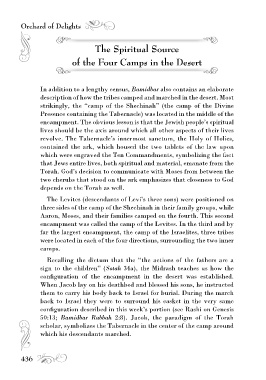Page 436 - 24107
P. 436
24107-EYAL - 24107-EYAL | 14 - A | 18-01-28 | 12:12:05 | SR:-- | Cyan
24107-EYAL - 24107-EYAL | 14 - A | 18-01-28 | 12:12:05 | SR:-- | Black
#24107-EYAL - 24107-EYAL | 14 - A | 18-01-28 | 12:12:05 | SR:-- | Yellow
24107-EYAL - 24107-EYAL | 14 - A | 18-01-28 | 12:12:05 | SR:-- | Magenta
#
#24107-EYAL - 24107-EYAL | 14 - A | 18-01-28 | 12:12:05 | SR:-- | Yellow 24107-EYAL - 24107-EYAL | 14 - A | 18-01-28 | 12:12:05 | SR:-- | Magenta 24107-EYAL - 24107-EYAL | 14 - A | 18-01-28 | 12:12:05 | SR:-- | Cyan 24107-EYAL - 24107-EYAL | 14 - A | 18-01-28 | 12:12:05 | SR:-- | Black
#
Orchard of Delights 14 Bechukotai
£The Spiritual Source The Spiritual Source The Spiritual Source £The Paradigm of Seven Times Seven£The Paradigm of Seven Times SevenThe Paradigm of Seven Times Seven
££
£
of the Fof the F
of the Four Camps in the Desertour Camps in the Desertour Camps in the Desert
The forty-nine “curses” mentioned in Bechukotai are clearly
connected to the mitzvah to count forty-nine days between Pesach
In addition to a lengthy census, Bamidbar also contains an elaborate and Shavuot, when we celebrate the giving of the Torah at Sinai. A
description of how the tribes camped and marched in the desert. Most beautiful allusion to this is the fact that Bechukotai is read before
strikingly, the “camp of the Shechinah” (the camp of the Divine the holiday of Shavuot every year. Demonstrating another link
Presence containing the Tabernacle) was located in the middle of the between the two, the Torah uses the number seven in both instances.
encampment. The obvious lesson is that the Jewish people’s spiritual In Bechukotai God repeatedly warns the Jewish people that if they
lives should be the axis around which all other aspects of their lives do not fulfill the covenant they will be afflicted “seven times for your
revolve. The Tabernacle’s innermost sanctum, the Holy of Holies, sins,” and the period of counting the forty-nine days is described
contained the ark, which housed the two tablets of the law upon repeatedly in the Torah as “seven times seven weeks.”
which were engraved the Ten Commandments, symbolizing the fact
that Jews entire lives, both spiritual and material, emanate from the The Sabbatical year also partakes in a cycle of “seven times seven”
Torah. God’s decision to communicate with Moses from between the years, culminating in the fiftieth year, the Jubilee year, when freedom
two cherubs that stood on the ark emphasizes that closeness to God was proclaimed and all Hebrew indentured servants went free and the
depends on the Torah as well. land reverted to its original owners. The formula of seven times seven
years followed by the Jubilee year is mirrored by the counting of
The Levites (descendants of Levi’s three sons) were positioned on seven times seven weeks that culminates in Shavuot, the fiftieth day.
three sides of the camp of the Shechinah in their family groups, while Shavuot is similar to the Jubilee year in that indentured servants are
Aaron, Moses, and their families camped on the fourth. This second freed in the Jubilee year and the Giving of the Torah is perceived to
encampment was called the camp of the Levites. In the third and by have been the final act of redeeming the Jewish slaves from Egypt,
far the largest encampment, the camp of the Israelites, three tribes for “one can only be truly free when immersed in the Torah.”
were located in each of the four directions, surrounding the two inner
camps. The connection between Bechukotai and Shavuot is also alluded
to by the opening words of the portion, “if you walk in My decrees.”
Recalling the dictum that the “the actions of the fathers are a The Jewish people literally walked from Egypt to Mount Sinai.
sign to the children” (Sotah 34a), the Midrash teaches us how the During this period of forty-nine days they had to cleanse themselves
configuration of the encampment in the desert was established. of the forty-nine levels of impurity they had sunk to in Egypt. Even
When Jacob lay on his deathbed and blessed his sons, he instructed today these days are ones of intense spiritual striving as we attempt
them to carry his body back to Israel for burial. During the march to ascend a level each day, exchanging impurity for purity.
back to Israel they were to surround his casket in the very same
configuration described in this week’s portion (see Rashi on Genesis In Bechukotai, the Torah repeatedly describes Israel’s dismissive
50:13; Bamidbar Rabbah 2:8). Jacob, the paradigm of the Torah attitude towards spiritual advancement with the term “keri,”
scholar, symbolizes the Tabernacle in the center of the camp around which, in this context, means casualness and implies a flippant and
which his descendants marched. irresponsible attitude: “If despite these you will not be chastised
towards Me, and you behave casually with Me” (Leviticus 26:23).
436 429

